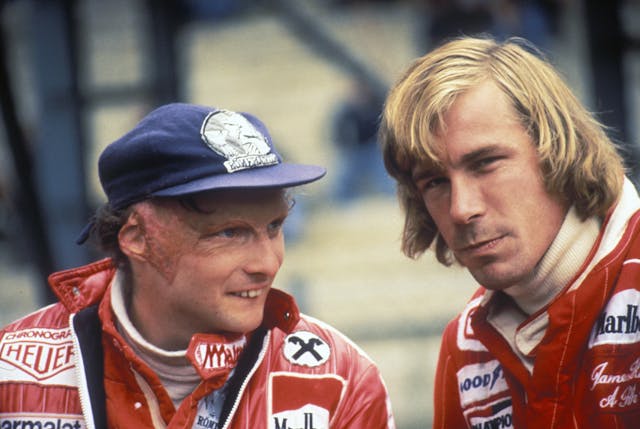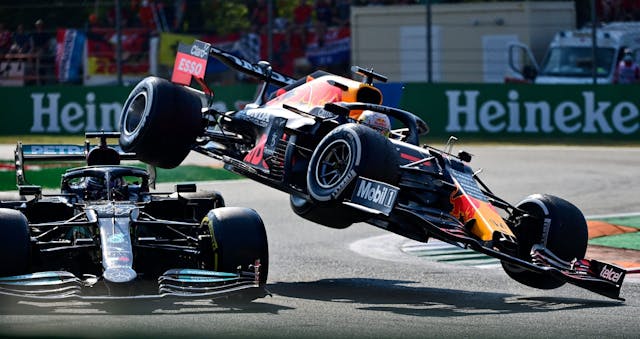3 great rivalries that brought out the best of Formula 1 competition
Fast cars alone don’t make for good racing. You can crow about mechanical differences and technology advancements all day long, but in the end it’s more like comparing stats on a baseball card or numbers in a video game. Dominance on the track only goes so far, too, because results and numbers aren’t what captivates and commands wide audiences in the long run. What keeps racing truly interesting are the human stories—oftentimes purely emotional dramas that spill onto the track when two personalities, and not just their machines, clash. Let’s look at today’s most passionate F1 rivalry, between Lewis Hamilton and Max Verstappen, in the context of two of the sport’s prior famous face-offs.
Verstappen vs. Hamilton
Max Verstappen and Lewis Hamilton are making Formula 1 exciting to watch again, and their spats back and forth during the 2021 season have fueled headlines even outside our venerable automotive-obsessed media circles. The Brazilian GP in Sao Paolo ended in another round of controversy between the two drivers, with a hotly contested appeal on Verstappen’s wide-going turn that forced Hamilton off track. It was the culmination of much back-and-forth between the 24-year-old Dutchman and the 36-year-old-Brit as the two competitors claw up the leaderboard in Formula 1 season points. Hamilton, a driver known from the beginning of his quest in Formula 1 as fresh talent, carried much of the same bold tenacity in his early career, perhaps making Verstappen’s constant digs and dives that much more welcome for some viewers seeking a challenge to Lewis’ supremacy.

That takes nothing away from the silver missiles from Mercedes, which are truly dominant when given the room to run. But in the thick of it, Verstappen has been taking advantage of the few instances in which Lewis leaves any speed behind. Verstappen currently sits atop the driver leaderboard, and his doggedness has appeared to, at times, do something to the British phenom that up to this point has appeared impossible: unsettle one of the sport’s most mythical drivers. Hamilton’s long-rising trajectory now runs the risk of being upset by the increasingly personal on-track battles he’s fighting.
Lauda vs. Hunt
The rivalry between Niki Lauda and James Hunt is a classic, although complex, one. Marked by fierce racing and danger amid an ultimately deep friendship, the differing attitudes of these two drivers made history in the 1976 season. (These events were captured in the 2013 biopic, Rush, inspired by the Hollywood-worthy scores of drama that played out in real life, as well as on track.)

The duo had become fast friends while racing Formula Three. The natural attractiveness of the party-prone Hunt with the more straitlaced Austrian translated into a unique rivalry that fed off of each other’s tit-for-tat accomplishments. Lauda’s first Formula 1 championship in ‘75 would fuel Hunt’s pursuit for the title after joining McLaren for 1976 season. That year started off with Lauda chiseling away at the top spot early in the season. Then, infamously, at the German Grand Prix, the Green Hell would remind the world of its danger when Lauda’s Ferrari 312T2 collapsed the rear suspension, crashing him. The fire that erupted severely burned Lauda, eventually putting him into a coma. Still, with Hunt closing the gap in points, Lauda wouldn’t let his rival take it easily; he returned after two races to the Italian Grand Prix and rounded out the last four races of the season. Hunt ended up winning the season by a single point after Lauda retired from the finale at a rainy Fuji Speedway, jaded from his injuries in Germany and wary of putting his life on the line again. In the following year, Lauda would return to Formula 1 with a vengeance, securing his second championship while Hunt faltered as the defending champ.
Rivalries aren’t always born from strife. It’s often a mutual respect that pushes competitors to test each other at the limits of their sport, simply for the joy of fresh challenge rather than a pure drive to win at all costs.
Senna vs. Prost
Mutual respect, of course, is not always the catalyst for a potent rivalry. Just look at Ayrton Senna and Alain Prost practically coming to fisticuffs at triple-digit speeds, brutally gaming every possible rule, referee, and racing line in order to pick away at each other—even while racing on the same team!

While modern racing politics emphasize juicy manufacturer titles over driver autonomy, little of this selfless team-first strategy played out between Senna and Prost. What happened on track between these two often went in the face of team orders, most notably at Imola in 1989 when the pair—while both racing for McLaren—qualified at the top of the field and agreed that whomever made it out of grid and into the first corner ahead would earn the lead for the duration of the race. The start-line drag race ended with Senna diving in first, then holding the lead (as agreed) over Prost. The latter, however, considered the deal valid for renegotiation following a restart of the race instigated by Gerhard Berger’s crash. Prost took the jump on Senna and held that position, leading to a heated lap-by-lap battle that ended with Senna back on top. Remember, tensions were already high at this point, only one year removed from Senna joining McLaren for the 1988 season and winning the driver’s title that year. But the battle at Imola in ’89 cemented what was already shaping up to be a true frenemy relationship between the two legendary drivers. Throughout the rest of the 1989 season, the dynamic would evolve into a trade-off of first- and second-place finishes, the tenacious rivalry continued after Prost moved on to Ferrari. Their dynamic would eventually evolve into a true friendship, especially as Prost grew to appreciate Senna’s accomplishments as more than just an attack on his own success.
So, rivalries. They matter because they remind us that the sponsor-clad robots behind the wheel are, in fact, relatable human beings. The visceral experience of internal combustion, the conquests against speed and distance and endurance, all of it is marvelous and constantly improving. But most of us won’t get anywhere close to multi-million dollar race car, while the experience of suffering a talented cohort operating outside their element, facing off against a worthy foe, and finding friendship with that opponent as you both skirt the outer edges of your capabilities? That’s the game of life, here manifested in a show of 200+ mph chess.
Think we’ve only scratched the surface? Tell us in the Hagerty Community which drivers you think put on the greatest performance while chasing greatness.


